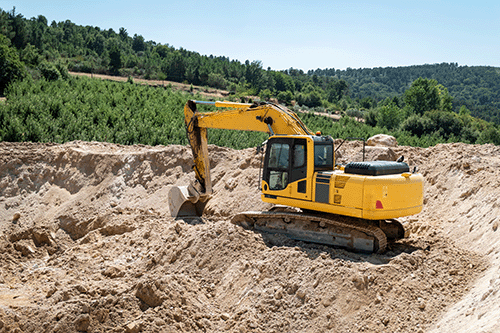Partner with Downstream

Choosing the right excavator size is essential for ensuring efficiency, cost-effectiveness, and productivity in any construction or excavation project. If your excavator is too small, it won’t generate enough power to complete the task efficiently. On the other hand, an oversized machine may be costly and difficult to maneuver. This guide will help you determine the force you need for your project, explain the different force ranges excavators offer, and highlight the benefits of mini excavators for smaller jobs.

Before selecting an excavator, it’s essential to understand the different forces that contribute to its digging capability. The two primary forces to consider are:
• Bucket Curling Force – The force exerted when the bucket curls inward, used for digging and scooping materials.
• Arm Crowd Force – The force generated by the arm cylinder, which pushes the bucket into the ground.
The required digging force depends on factors like soil composition, project depth, and material density. For example, clay and compacted soil require a machine with higher force output, while loose sand or gravel can be handled by smaller excavators.
Excavator Force Ranges and Sizes
Excavators are categorized by their weight and force capacity, making it easier to match the machine to your project. Here’s a breakdown of the different excavator sizes and their applications:
Mini Excavators (1-2 tons)
Mini excavators are perfect for light-duty tasks such as landscaping, trenching, and small-scale digging projects. They typically generate 3,000 to 4,000 lbs of bucket breakout force. Their small size allows them to work in tight spaces, making them ideal for urban construction and backyard projects. Kobelco highlights their efficiency in projects where space is limited but precise excavation is needed.
Compact Excavators (3-5 tons)
For projects requiring a bit more power but still needing maneuverability, compact excavators provide 8,000 to 12,000 lbs of breakout force. These machines are commonly used in utility work, small construction sites, and foundation digging. Bobcat notes that compact excavators are among the most versatile machines in the industry, balancing power and accessibility.
Standard Excavators (10-45 tons)
Standard excavators, often referred to as full-sized excavators, are used in major construction projects like roadwork, mining, and large-scale demolition. With 20,000 to 60,000 lbs of bucket breakout force, they offer the power needed to handle rocky terrains, compacted soil, and deep excavations. Caterpillar provides a range of standard excavators that excel in earthmoving and site preparation.

Large Excavators (45+ tons)
At the top end of the spectrum, large excavators provide over 100,000 lbs of bucket breakout force and are essential for mining, pipeline installation, and heavy infrastructure projects. Machines like the Hitachi EX8000-6 are designed for massive excavation projects requiring extreme power and durability.
Mini Excavators: A Small Machine with Big Benefits
Mini excavators have become increasingly popular due to their versatility and accessibility. These machines excel in several key applications:
• Urban Construction – Their compact design allows them to work in tight spaces without causing major disruptions to surrounding areas.
• Landscaping – Mini excavators are perfect for digging ponds, tree planting, and irrigation installations.
• Utility Installation – They are often used for laying pipes and cables, especially in narrow spaces where larger excavators wouldn’t fit.
According to Compact Equipment, mini excavators have impressive power-to-size ratios, making them suitable for tasks that demand precision digging.
Downstream: Your Go-To Excavator Rental Solution
When selecting an excavator, it’s crucial to match the machine to your specific project needs. Whether you need a mini excavator for tight spaces or a large excavator for heavy lifting, renting from a trusted provider ensures you get top-quality equipment without the high cost of ownership.
At Downstream, we provide a wide range of excavators, from mini to heavy-duty models, ensuring you find the right fit for your job. Our expert team is here to help you choose the best machine for your project, optimizing both efficiency and cost.
Final Thoughts
Selecting the right excavator size involves understanding digging forces, material resistance, and project scope. Mini excavators offer versatility for small-scale projects, while large excavators provide the power needed for heavy-duty applications.
By renting your equipment from Downstream, you ensure cost-effective, high-quality solutions tailored to your excavation needs. Whether you’re digging trenches, laying foundations, or moving heavy materials, the right excavator makes all the difference!
-min.webp)
Quis nostrud exercitation ullamco laboris nisi ut aliquip ex ea commodo consequat. Duis aute irure dolor in voluptate.
